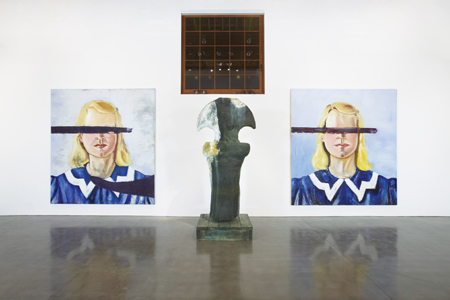Julian Schnabel

On the westernmost block of 11th Street in Manhattan, a former hangout for transsexual hookers that now abuts a Michelin-starred Austrian restaurant, stands one of New York’s great white elephants: the Palazzo Chupi, an acid dream of a Venetian pile that plops a fluorescent colonnaded manse on top of a dark Big Apple carriage house. (The name comes from the Spanish lollipops briefly fashionable last decade.) It’s the home and studio of Julian Schnabel, and it’s always seemed to me a palimpsest of two money-soaked eras: a Reaganite 1980s confection overlaid onto a Bloomberg-loving plutocrat’s mansion. But there’s money and then, you know, there’s money. Half an hour up the road from Palazzo Chupi, in relatively low-tax Connecticut, the Brant Foundation Art Study Center rises alongside a precisely manicured polo field, and there even Schnabel’s luxuries look tatty. In the first room of the exhibition stood a gilded bed of his own design from Palazzo Chupi. In the hushed galleries of Greenwich, it seemed downright bohemian.
This was Schnabel’s first full-scale retrospective in the US since his lambasted Whitney Museum of American Art exhibition of 1987, and it’s useful to consider what made this return possible. His undeniably accomplished films – notably The Diving Bell and the Butterfly (2007), a portrait of a French journalist suffering from locked-in syndrome – prompted critics to look again at an artist so loathed for so long. A wider reconsideration of painting from the 1980s, whose historicization is now well under way via exhibitions such as Helen Molesworth’s ‘This Will Have Been: Art, Love and Politics in the 1980s’, at the Institute for Contemporary Art in Boston, has also helped. Above all, the unceasing rise of the art market in an era when public institutions are withering has given him a new lease of life. Schnabel, the poster child for the last boom in the art market, has had a second wind in the current one, evidenced by his current large show in New York at one of Larry Gagosian’s many art consumption centres. That has extended past private institutions: in 2011, Norman Rosenthal curated a Schnabel retrospective at Venice’s Museo Correr.
Looking critically at Schnabel’s large, messy paintings is a tricky undertaking, because like almost no other artist he is overexposed and underexposed at once. Though I approached my trip to Greenwich with the resignation I feel for other ubiquitous and expensive bad boys, I quickly realized that I’d seen almost none of the paintings here outside of reproduction, not even the famous plate paintings of the late 1970s and early 1980s, which include both antique-looking and chintzy shards of tableware against freewheeling abstractions. And time has tamed them. The ‘big girl’ paintings, featuring a chastely dressed blonde with her eyes obscured by a raw black slash, looked less overblown than I’d expected from photographs, and the dark swath felt less like a censorious gesture than a modernist repudiation of figuration as such. Even the absurd scale of such paintings as El Espontaneo (For Abelardo Martinez) of 1990 – which, at 45 square metres is the size of a small studio apartment – feels a bit less bombastic, especially now that massively scaled galleries like the Brant Foundation’s are the norm.
Here and there the show surprised, usually at small scale: in a little drawing of the murdered Italian prime minister Aldo Moro (Study for ‘Aldo Moro’, 1978), for example, or a few early abstractions whose hermetic symbolism recalled the mysticism of Hilma af Klint. But a healthy preponderance of the art included in this retrospective was terrible. The plate paintings and most of the other large-format works are histrionic for their own sake, so unrestrained and egotistical as to block out any underlying virtues. Later paintings, with a few exceptions like the ‘big girls’, exhibit little maturity and in some cases veer into unspeakable kitsch, such as The Sky of Illimitableness (2012), a giant portrait of a sheep against a cloudy purple background of the kind that you might find in a department store photo lab. And the show closed in jaw-dropping fashion, with craft-store-quality plate portraits of the Brant family themselves, including the former model Stephanie Seymour and her daughter Lily Brant, shamelessly included as a reminder of who calls the shots.
Assess an artist’s career by the ratio of good work to bad, and Schnabel is an irrelevance. That isn’t how art history works, though – it’s a messier and more volatile enterprise, defined through relationships and networks as much as individual art works, and by the end of this exhibition
I felt that Schnabel can’t be so easily dismissed, even if so little of the work shows any force or engagement. The machismo, the egotism, the indecent lack of any discrimination or criticality: these still grate, and time has not revealed any hidden virtues in compensation. But in New York today, a younger generation of equally grating (and sometimes even more expensive) artists occupy our big-box galleries and our fashion magazines, and at least Schnabel, unlike them, is still taking chances and risking embarrassment. Amid a second, even larger market boom that shows no sign of bursting like its 1980s predecessor, Schnabel appears less as a rock star than as a somewhat neglected elder statesman, and as I walked out of this show and onto the lustrous polo field, my dominant emotion was not anger but a resigned acceptance.















